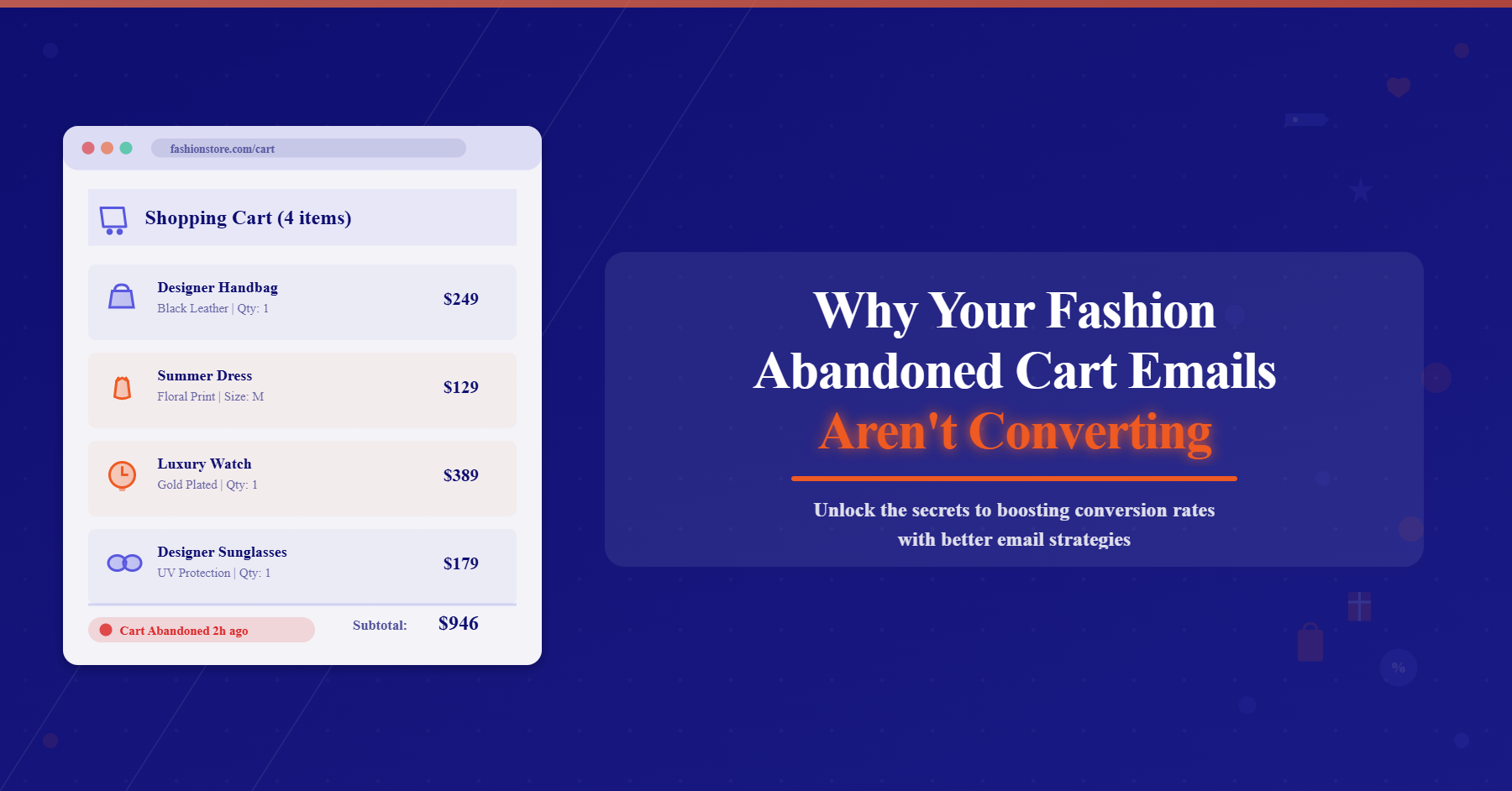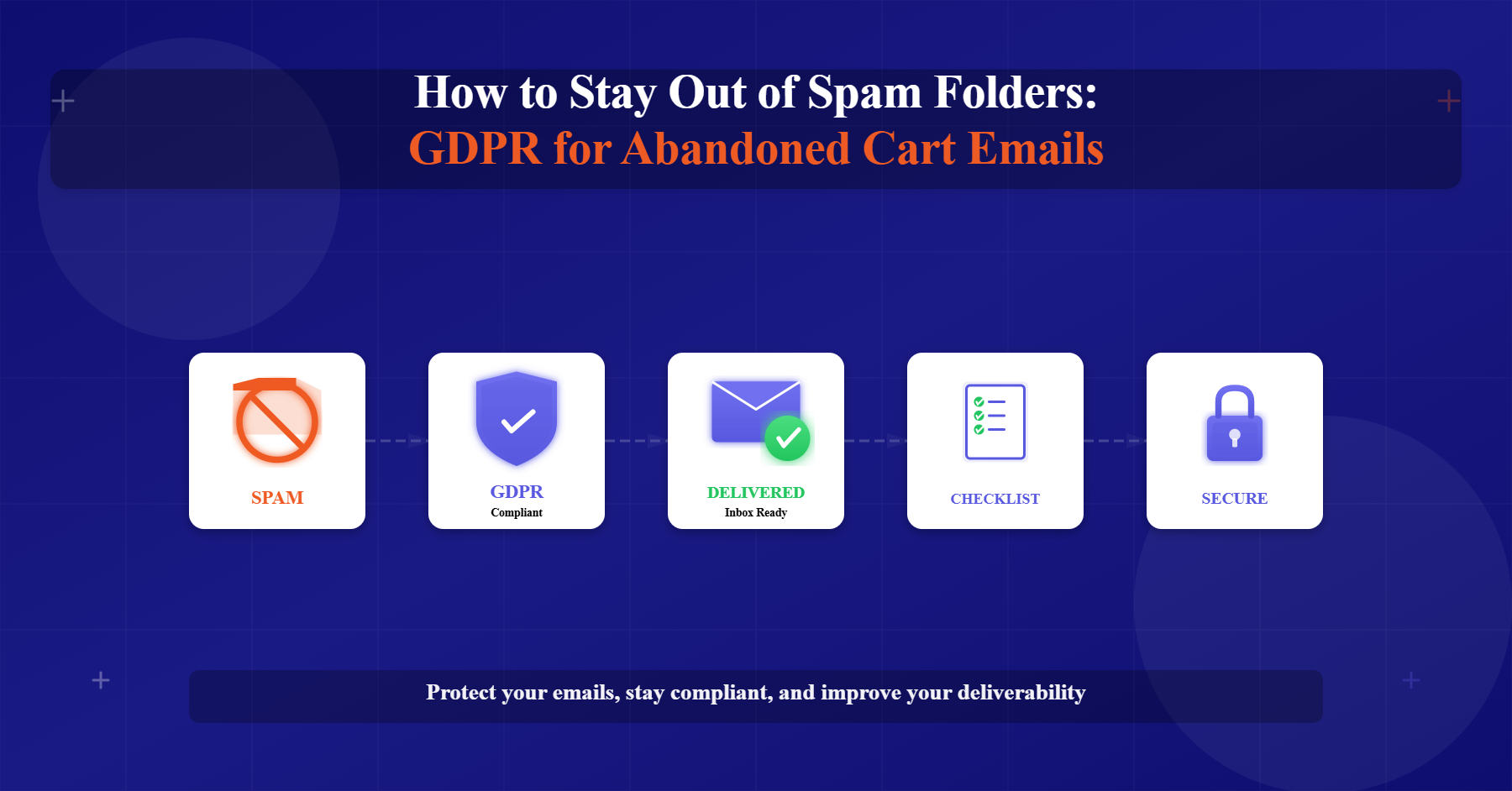You might be leaving money on the table if you are overlooking the obvious email automation flow gaps in your store.
Email automations are great for saving hours of productive time while engaging your customers. But how do you know you’re doing it right?
In this guide, we’ll walk you through the 14 must-have eCommerce brand email flows for every eCommerce store. And the best practices to get the most out of them.
What Are E-commerce Email Flows?
Email flows are automated email sequences sent to customers that are triggered by specific actions or events. Unlike one-off campaigns, these automated emails are sent based on behavior, naturally making them timely, relevant, and personalized. To take personalization further, you can automate personalized email image generation using an API to dynamically tailor visuals for each customer.
But Why Do They Matter?
Email flows are sent when your customers are most receptive to the emails you send them. It results in stronger customer engagement, increasing the chances of them making a purchase or completing a desired action. It could be leaving a product review or signing up for a loyalty program.
By automating these processes, you can operate at scale without compromising on providing a great customer experience.
Higher engagement: Automated emails have a 70% higher open rate than one-off promotional emails.
Better personalization: Segmentation and automation allow you to send hyper-relevant content.
Increased revenue: Well-optimized email flows can contribute to up to 30% of total eCommerce revenue.
When optimized effectively, automated email flows can become a major revenue driver for eCommerce brands like yours.
14 Essential E-commerce Brand Email Flows You Need
It is a no-brainer that every eCommerce store needs automated email flows. But what are the flows that you should prioritize? And what should you know before setting them up?
Email flows can be categorized into four key types based on the stage of the customer’s purchase journey. Pre-Purchase, Post-Purchase, Retention & Re-Engagement, and Promotional & Seasonal.
Each category serves a specific role helping you align with what your customers are expecting from your brand.
A. Pre-Purchase Email Flows (Lead Generation & Nurturing)
Pre-purchase email flows focus on converting prospects into customers by engaging them early and providing value-driven touchpoints. Leveraging an email finder tool can help eCommerce brands identify high-quality prospects and seamlessly feed them into these pre-purchase flows for better conversion.
1. Welcome Series Email Flows
Your welcome email is the first impression customers get of your brand. It’s your opportunity to make them feel good for opting in, set expectations, and show value. A well-written welcome email makes you look relevant and worth checking out your store.
Structure of a high-converting welcome series
Email 1: Welcome + brand story.
Email 2: Social proof, bestsellers, or educational content.
Email 3: Discount reminder (if offered).
This structure works because it provides a gradual, value-driven approach to your customer conversion. The first email introduces your brand and builds a relationship, and the second reinforces trust with social proof. The third email will create an urgency with a discount reminder prompting action from your customers.
This sequence strategically nurtures your leads, and minimizes the friction and conversion blockers, increasing the likelihood of a purchase.
💡 Pro Tip: Segment new subscribers based on their signup source (social media, website, referral) and personalize messaging accordingly.
2. Browse Abandonment Email Flows
Shoppers browse your store but don’t always add to the cart. That’s where browse abandonment emails come in.
‘Browse abandonment emails’ to your customers reignite interest in previously viewed products. These timely emails re-engage shoppers, guiding them back to your store to pick up where they left off.
Best Practices For Browse Abandonment Emails
Personalize product recommendations: Use dynamic content to display recently viewed items.
Leverage urgency and scarcity: Highlight low-stock alerts to encourage immediate action.
Incorporate social proof: Show customer reviews or testimonials for the browsed product.
Use a clear CTA: Make it easy for users to return to their browsing session with a ‘Continue Shopping’ button.
Send at the right time: Test different send times to optimize open and click-through rates.
💡 Pro Tip: Use dynamic content to promote products based on customers’ browsing history.
3. Abandoned Cart Email Flows
70% of online shopping carts are abandoned. Abandoned cart emails help recover lost sales by reminding customers to complete their purchases. Here’s how you can improve your conversion rate with abandoned cart emails.
Best Practices For Abandoned Cart Emails
Send the first email within an hour: Immediate reminders keep your brand top-of-mind while purchase intent is still high.
Use personalized subject lines: Address the customer by name and mention the abandoned product to increase open rates.
Use product images and details: A visual reminder helps rekindle purchase intent.
Create urgency and scarcity: Use phrases like “Only a few left in stock” to encourage immediate action.
Include customer testimonials and reviews: Reinforce trust by displaying positive feedback from previous buyers.
Offer an incentive in the final email: A small discount or free shipping can help seal the deal.
Note: Abandoned cart emails have an average conversion rate of 18%.
4. Abandoned Checkout Email Flows
Automated abandoned checkout emails are essential for recovering lost sales and ensuring high-intent buyers complete their purchases.
These emails address common reasons for abandonment such as unexpected costs, lengthy checkout processes, or hesitation. With a simple reinforcement, or with an incentive, like free shipping, abandoned checkout emails reduce friction and increase conversions.
Studies show that well-optimized abandoned checkout emails can recover up to 30% of lost sales, making them a critical component of any eCommerce email strategy.
💡 Pro Tip: Include a one-click checkout button to remove friction.
B. Post-Purchase Email Flows (Customer Experience & Loyalty)
5. Order Confirmation Email Flows
Order confirmation emails elevate the customer experience with your brand after completing a purchase. They confirm that the customer transaction was successful. It helps in reducing uncertainty and potential buyer’s remorse.
Order Confirmation Email Flow Best practices
Personalize the emails with the customer’s name and order details.
Include an order tracking link and estimated delivery time in your order confirmation emails.
Additionally, these emails tend to improve customer trust and engagement, leading to higher retention and repeat purchases.
6. Shipping Confirmation Email Flows
Notifying your customers that their orders are on the way keeps them in the loop. It is an effective way to increase customer satisfaction and reduce customer service inquiries.
💡 Pro Tip: You can try upselling related products in your confirmation email.
7. Delivery Confirmation Email Flows
Delivery confirmation emails encapsulate the complete purchase experience of the customer with your brand. Additionally, these emails create an opportunity to keep your customers engaged beyond this purchase, promoting related products. Or offering incentives for future purchases, strengthening customer loyalty.
Delivery Confirmation Emails Best practices
Ask for feedback on the delivery experience.
Offer a discount on their next purchase.
8. Review Request Email Flows
Customer review request emails collect assets for your eCommerce store that can directly increase sales and revenue. Automating your review request emails after a customer receives an order increases your chance of collecting positive reviews that can boost sales in your store.
Reviews also provide valuable feedback for product improvements and marketing strategies. Particularly in improving your SEO and increasing visibility, bringing more organic traffic to your store.
💡 Pro Tip: Offer an incentive (e.g., discount, loyalty points) for leaving a review.
9. Product Recommendation Emails
Ever browsed Amazon and noticed how they always suggest products that just make sense? That’s product recommendation emails at work!
These emails are all about encouraging repeat purchases by suggesting relevant products based on past purchases or browsing behavior. Why does this matter? Because personalized recommendations can increase revenue per recipient by more than 300%.
Best Practices for Product Recommendation Emails
Use past purchases to personalize recommendations. If someone just bought a coffee machine, suggest coffee beans, filters, or a milk frother.
Highlight trending and best-selling items. People love social proof. If others are buying it, they’re more likely to do the same.
Make the CTA specific and simple. Instead of a bland “Shop Now,” try “Complete Your Setup” or “Level Up Your Style.”
Use dynamic content. Automated AI-based recommendations work wonders. If a shopper has browsed a product multiple times but hasn’t purchased it, remind them!
Pro Tip: Add a time-sensitive incentive, like “Grab this at 10% off for the next 48 hours!” Urgency drives conversions.
10. Replenishment Email Flows (For Consumable Products)
These automated email flows fit only the brands selling consumable products (think skincare, supplements, pet food, etc.). Replenishment emails come with a minimum guarantee once you set them up the right way.
Why? Because people forget to restock until it’s too late. A reminder email at just the right time makes their life easier and boosts your sales.
Best Practices for Replenishment Emails
Send based on estimated usage cycles. If a 30-day supply of vitamins is purchased, send a reminder on day 25.
Offer a subscription option. Make it easy to reorder automatically (hello, steady revenue!).
Include a one-click reorder button. Simplicity removes any friction in the customer buying journey.
Pair replenishment with product recommendations. If they’re buying shampoo again, suggest the matching conditioner.
Pro Tip: Add a small discount for auto-reordering: “Never run out again! Subscribe & save 10%.”
C. Retention & Re-Engagement Email Flows
Retention and re-engagement emails keep your customers coming back. While acquiring new customers is exciting, retaining them is where the real profits are.
Post-purchase automation flows play a huge role in business growth. Happy customers buy again, tell their friends, and turn into brand advocates.
11. Customer Winback Email Flows
Are customers ghosting you? It happens. But that doesn’t mean they’re gone forever.
Winback emails help rekindle customer relationships and remind them why they loved your brand in the first place.
Best Practices for Customer Winback Emails
Use a friendly tone. “We miss you! Here’s 15% off to welcome you back.”
Share new arrivals. Maybe they left because they got bored? Show them what’s new!
Personalize the offer. If they always buy skincare, don’t send them an email about shoes.
Test different incentives. Some people love discounts, while others prefer exclusive perks.
Pro Tip: A subject line like “[Name], a special treat just for you” can boost open rates significantly!
12. VIP & Loyalty Program Email Flows
Your most loyal customers deserve extra love! VIP & loyalty program emails are designed to recognize, reward, and retain high-value customers, ultimately increasing their lifetime value and fostering deeper brand loyalty.
VIP and loyalty program automated emails keep your best customers engaged by offering exclusive perks, early access to new products, and tailored rewards. These emails also encourage repeat purchases by making customers feel appreciated and incentivized to continue shopping with your brand.
How VIP & Loyalty Program Emails Work
Enrollment Emails: Welcoming new members to your loyalty program and explaining the benefits.
Points Balance Updates: Regularly inform customers about their current points, upcoming rewards, and how close they are to the next tier.
Exclusive Offers & Perks: Providing early access to sales, limited-time discounts, or free shipping to VIP customers.
Milestone Celebrations: Recognizing customer birthdays, anniversaries, or major spending milestones with personalized offers.
Impact of VIP Programs on Business Growth
Loyalty program members spend 12-18% more per year than non-members.
83% of customers say being part of a loyalty program influences their decision to continue shopping with a brand.
Personalized reward emails can lead to a 40% higher engagement rate compared to generic promotional emails.
Best Practices for VIP & Loyalty Program Emails
Segment your VIP customers. Offer perks like early access to sales, gifts, or exclusive content.
Gamify it! Show their points and how close they are to the next reward tier.
Celebrate milestones. Birthdays, anniversaries, or hitting a spending threshold = a great reason to send an email.
Pro Tip: “You’re just $10 away from a $50 reward!” can drive impulse purchases.
D. Promotional & Seasonal Email Flows
Promotional and seasonal emails capitalize on high-shopping periods. A well-timed seasonal campaign can bring the hockey-stick growth to your sales numbers.
13. Holiday & Seasonal Campaign Flows
Black Friday, Cyber Monday, Christmas, and Valentine’s Day… are massive revenue drivers because they tap into peak consumer spending periods. For example, in 2024, Black Friday sales in the U.S. hit a record $10.8 billion in online spending alone.
Seasonal campaigns create urgency and capitalize on consumer shopping habits, resulting in higher conversions. Brands like Sephora, for instance, use exclusive holiday bundles and limited-time offers to drive engagement, while Amazon’s Prime Day demonstrates how time-sensitive promotions can generate billions in sales.
By planning strategic seasonal email flows, eCommerce brands can maximize profitability during these critical shopping events.
Strategies for Executing Holiday Email Campaigns
Start early. Build anticipation with teaser emails.
Create urgency. “Only 24 hours left for our biggest sale!”
Highlight gift guides. Make shopping easier for your audience.
Optimize for mobile. Shoppers check deals on their phones!
Pro Tip: Add a countdown timer inside your email for extra urgency.
14. Price Drop & Back-in-Stock Alerts
If someone wanted an item but didn’t buy it due to price or availability, they want to know when it is back!
Price drops and back-in-stock alerts create a sense of urgency and excitement, encouraging customers to complete their purchases. Brands like Best Buy and Amazon effectively use these alerts to re-engage potential buyers and recover lost sales. These automated emails capitalize on intent, making it easier for businesses to convert warm leads into customers by offering them the right information at the right time.
Best Practices For Price Drop & Back-in-Stock Alerts
Use behavior-based triggers. If someone browsed but didn’t buy, notify them when the price drops.
Keep it short and direct. “That item you loved? Now 20% off!”
Test different CTA placements. Try “Shop Now” vs. “Grab Yours Before It’s Gone!”
Best Practices for Setting Up E-commerce Email Flows
Use behavior-based triggers. Automated emails have a higher conversion rate compared to the other promotional email sends.
A/B test subject lines, copy, and CTAs. A/B testing subject lines and automating your campaigns can boost your email open rates.
Ensure mobile-friendly design. Over 60% of emails are opened on mobile devices says a Litmus study.
Leverage segmentation and personalization. Personalized emails deliver 6x higher transaction rates.
Use clear and compelling CTAs. Strong CTAs can increase click-through rates by 371% and sales by 161%.
Monitor performance and optimize. Marketers who analyze their email performance improve campaign results by up to 33%.
Get Started With Email Marketing Automation
Discounts and offers are not a sustainable strategy to increase your conversions. But a great brand experience is built with robust email automation helps you with minimal effort.
eCommerce brands email flows add a new dimension to customer experience which you should not be under-utilizing. Happy customers spend without second thoughts or have remorse after spending.
Built for eCommerce stores, TargetBay simplifies eCommerce email automation with behavior-based flows, high deliverability, and expert support. Do it right with TargetBay.
Book a free demo and get free migration with top-notch support today!






